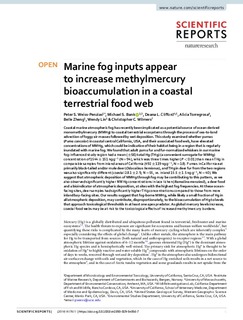| dc.description.abstract | Coastal marine atmospheric fog has recently been implicated as a potential source of ocean-derived monomethylmercury (MMHg) to coastal terrestrial ecosystems through the process of sea-to-land advection of foggy air masses followed by wet deposition. This study examined whether pumas (Puma concolor) in coastal central California, USA, and their associated food web, have elevated concentrations of MMHg, which could be indicative of their habitat being in a region that is regularly inundated with marine fog. We found that adult puma fur and fur-normalized whiskers in our marine fog-influenced study region had a mean (±SE) total Hg (THg) (a convenient surrogate for MMHg) concentration of 1544 ± 151 ng g−1 (N = 94), which was three times higher (P < 0.01) than mean THg in comparable samples from inland areas of California (492 ± 119 ng g−1, N = 18). Pumas in California eat primarily black-tailed and/or mule deer (Odocoileus hemionus), and THg in deer fur from the two regions was also significantly different (coastal 28.1 ± 2.9, N = 55, vs. inland 15.5 ± 1.5 ng g−1, N = 40). We suggest that atmospheric deposition of MMHg through fog may be contributing to this pattern, as we also observed significantly higher MMHg concentrations in lace lichen (Ramalina menziesii), a deer food and a bioindicator of atmospheric deposition, at sites with the highest fog frequencies. At these ocean-facing sites, deer samples had significantly higher THg concentrations compared to those from more inland bay-facing sites. Our results suggest that fog-borne MMHg, while likely a small fraction of Hg in all atmospheric deposition, may contribute, disproportionately, to the bioaccumulation of Hg to levels that approach toxicological thresholds in at least one apex predator. As global mercury levels increase, coastal food webs may be at risk to the toxicological effects of increased methylmercury burdens. | nb_NO |
